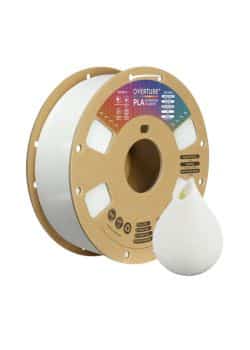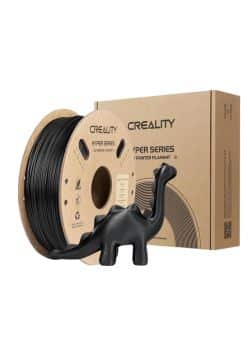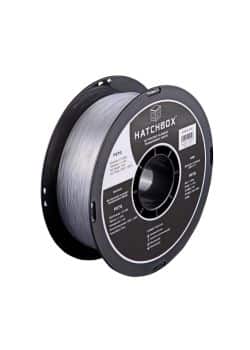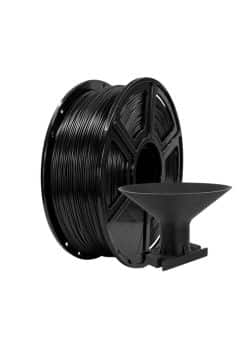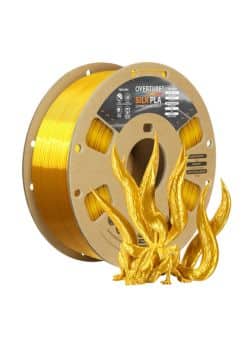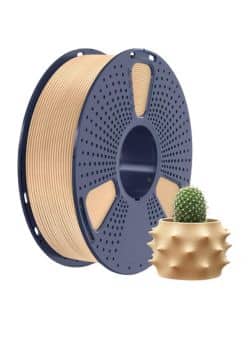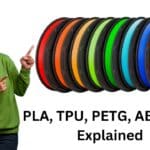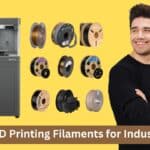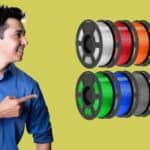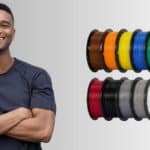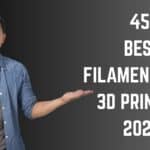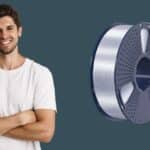
PLA, PETG, and TPU top the best 3D printing filaments for most projects, with Tough PLA, PCTG, and ASA as stellar upgrades—steer clear of F Tier unless you have niche needs.
If you’re into 3D printing, you know that choosing the right filament can make or break your project. With hundreds of options available, from tough-as-nails materials to flexible, cloud-like textures, it’s easy to feel overwhelmed. After testing over 300 filaments, I’ve created the ultimate 3D filament tier list to help you decide which spools deserve a spot in your workshop. Whether you’re a beginner or a seasoned maker, this guide will help you separate the best filaments from the rest.
Affiliate Disclosure
We participate in Amazon affiliate programs, earning fees from qualifying purchases via links at no extra cost to you. It’s how we keep this blog rolling and my 3D printers buzzing with fresh filament for reviews like this one!
Related: Best Beginner 3D Printers of 2025: Affordable Picks Under $500
What is a 3D Filament Tier List?
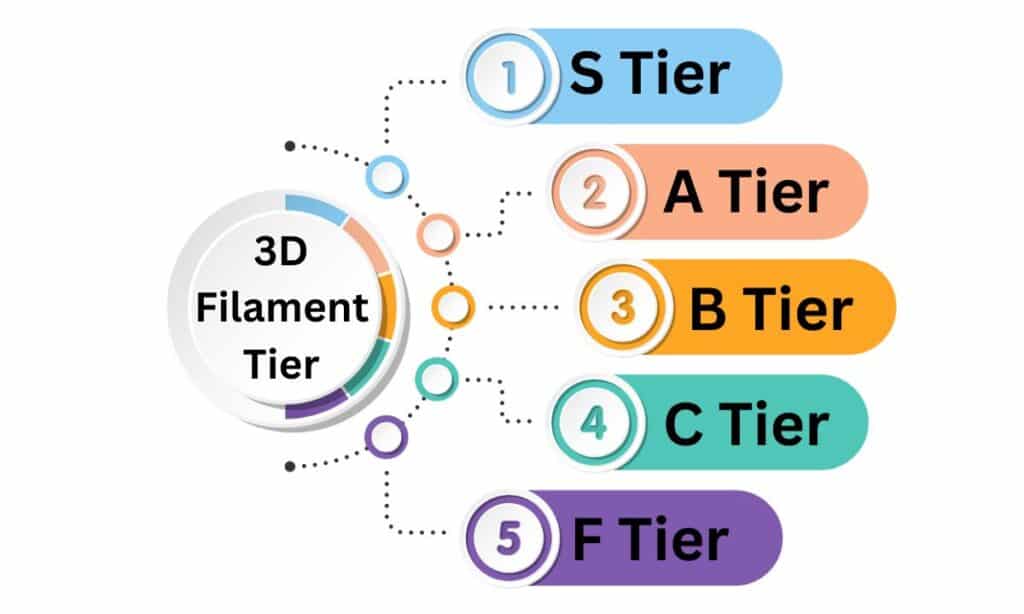
A 3D filament tier list ranks filaments based on their performance, ease of use, and versatility. Here’s how the tiers break down:
- S Tier: The best filaments for most projects. Design your prints around these if possible.
- A Tier: Excellent filaments with a wide range of applications.
- B Tier: Good filaments with some trade-offs, ideal for specific use cases.
- C Tier: Niche filaments that are useful in rare situations.
- F Tier: Avoid these filaments unless you have a very specific need.
This tier list is designed to help you choose the best 3D printing filaments for your needs, whether you’re printing functional parts, prototypes, or decorative items.
Related: 🚀Boost Your 3D Printing with Best FLASHFORGE Filaments of 2025!
S Tier: The Best 3D Printing Filaments
1. PLA (Polylactic Acid)
- Why It’s Great: PLA is the most popular 3D printing filament for good reason. It’s affordable, easy to print, and available in a rainbow of colors. It’s perfect for beginners and excels at bridges, overhangs, and fine details.
- Drawbacks: PLA softens in heat, degrades under UV light, and can be brittle.
- Best For: Prototyping, decorative prints, and beginner-friendly projects.
- Verdict: While PLA is a fantastic all-rounder, its limitations keep it in A Tier.
2. Carbon Fiber PLA (CFPLA)
- Why It’s Great: CFPLA combines PLA with carbon fiber for improved stiffness, detail, and stability. It’s ideal for functional parts and has a sleek, professional look.
- Drawbacks: Requires a hardened steel nozzle and is more brittle than standard PLA.
- Best For: Functional prototypes, mechanical parts, and high-detail prints.
- Verdict: CFPLA earns S Tier for its superior performance and aesthetics.
3. Tough PLA (PLA + PBT)
- Why It’s Great: A blend of PLA and polybutylene terephthalate (PBT), Tough PLA is more heat-resistant, impact-resistant, and durable than standard PLA.
- Drawbacks: Slightly more expensive than regular PLA.
- Best For: Light-duty functional parts and outdoor use.
- Verdict: Tough PLA is a straight upgrade to PLA and deserves S Tier.
4. High-Speed PLA
- Why It’s Great: Designed for fast printing, this filament melts at lower temperatures and has reduced viscosity, allowing for incredibly fast print speeds.
- Drawbacks: Less heat-resistant than standard PLA.
- Best For: Rapid prototyping and high-volume printing.
- Verdict: High-Speed PLA is S Tier for speed enthusiasts.
5. PCTG (Polycyclohexylene Dimethylene Terephthalate Glycol)
- Why It’s Great: PCTG is tougher, more water-resistant, and easier to print than PETG. It’s perfect for functional parts that need to withstand real-world abuse.
- Drawbacks: Expensive and harder to find.
- Best For: Durable prototypes, mechanical parts, and outdoor applications.
- Verdict: PCTG is S Tier for its near-perfect balance of properties.
6. TPU (Thermoplastic Polyurethane)
- Why It’s Great: TPU is flexible, durable, and perfect for wearables, phone cases, and tactical gear. It’s also easy to print and has excellent layer adhesion.
- Drawbacks: Absorbs water quickly and requires drying before use.
- Best For: Flexible parts, shock absorption, and wearables.
- Verdict: TPU is S Tier for its versatility and durability.
A Tier: Reliable Filaments for Everyday Use
1. PETG (Polyethylene Terephthalate Glycol)
- Why It’s Great: PETG is tougher than PLA, handles higher temperatures, and is more resistant to real-world abuse. It’s also transparent and has low friction.
- Drawbacks: Struggles with overhangs and supports, and absorbs water quickly.
- Best For: Functional parts, outdoor use, and transparent prints.
- Verdict: PETG is a solid A Tier choice for functional parts.
2. Carbon Fiber PETG (CFPETG)
- Why It’s Great: Carbon fiber stabilizes PETG, reducing warping and improving stiffness. It’s ideal for functional prototypes.
- Drawbacks: Requires a hardened nozzle and is more expensive.
- Best For: High-strength functional parts and prototypes.
- Verdict: CFPETG earns A Tier for its enhanced performance.
3. ASA (Acrylonitrile Styrene Acrylate)
- Why It’s Great: ASA is UV-resistant, tough, and has a handsome matte finish. It’s perfect for outdoor applications.
- Drawbacks: Releases styrene fumes during printing and requires an enclosure.
- Best For: Outdoor prints, automotive parts, and UV-resistant applications.
- Verdict: ASA is A Tier for its durability and weather resistance.
B Tier: Niche Filaments with Specific Uses
1. Silk PLA
- Why It’s Great: Silk PLA has a shiny, metallic finish that’s perfect for showpieces. It’s also easier to remove supports.
- Drawbacks: Weaker than standard PLA and prone to jamming.
- Best For: Decorative prints and cosplay props.
- Verdict: Silk PLA is B Tier for its aesthetic appeal.
2. Wood PLA
- Why It’s Great: Wood PLA contains sawdust, giving prints a realistic wood grain effect. It’s great for decorative items.
- Drawbacks: Weak, prone to moisture absorption, and difficult to print.
- Best For: Decorative items and artistic prints.
- Verdict: Wood PLA is B Tier for its unique look.
C Tier: Situational Filaments
1. ABS (Acrylonitrile Butadiene Styrene)
- Why It’s Great: ABS is tough, heat-resistant, and can be vapor-smoothed with acetone.
- Drawbacks: Warps easily and releases toxic fumes during printing.
- Best For: Functional parts and post-processing.
- Verdict: ABS is C Tier due to its printing challenges.
F Tier: Filaments to Avoid
1. Metal-Filled PLA
- Why It’s Bad: Metal-filled filaments are brittle, expensive, and offer no real strength benefits.
- Verdict: F Tier—stick to standard filaments and paint for metallic effects.
2. HDPE (High-Density Polyethylene)
- Why It’s Bad: HDPE warps excessively, has terrible bed adhesion, and is generally a nightmare to print.
- Verdict: F Tier—useful only for purging nozzles.
3D Filament Tier List: At a Glance
| Filament | Tier | Best Uses | Pros | Cons |
|---|---|---|---|---|
| PLA | A | Prototyping, decorative prints | Easy to print, affordable, wide color range | Brittle, low heat resistance, degrades in UV light |
| Carbon Fiber PLA | S | Functional parts, high-detail prints | Stiff, excellent detail, matte finish | Requires hardened nozzle, more brittle than PLA |
| Tough PLA | S | Light-duty functional parts | Heat-resistant, impact-resistant, durable | Slightly more expensive than PLA |
| High-Speed PLA | S | Rapid prototyping, high-speed prints | Fast printing, low viscosity | Less heat-resistant than standard PLA |
| PCTG | S | Durable prototypes, outdoor use | Tough, water-resistant, minimal warping | Expensive, harder to find |
| TPU | S | Flexible parts, wearables | Durable, flexible, excellent layer adhesion | Absorbs water, requires drying |
| PETG | A | Functional parts, outdoor use | Tough, heat-resistant, transparent | Struggles with overhangs, absorbs water |
| Carbon Fiber PETG | A | High-strength functional parts | Stiff, reduced warping, professional look | Requires hardened nozzle, more expensive |
| ASA | A | Outdoor prints, UV-resistant parts | UV-resistant, tough, matte finish | Releases fumes, requires enclosure |
| Silk PLA | B | Decorative prints, cosplay props | Shiny finish, easy support removal | Weaker than PLA, prone to jamming |
| Wood PLA | B | Decorative items, artistic prints | Realistic wood grain effect | Weak, absorbs moisture, difficult to print |
| ABS | C | Functional parts, post-processing | Tough, heat-resistant, can be vapor-smoothed | Warps easily, releases toxic fumes |
| Polycarbonate (PC) | C | High-stress applications | Extremely tough, heat-resistant | Difficult to print, absorbs moisture, requires high temps |
| Metal-Filled PLA | F | Decorative metallic finishes | Metallic look | Brittle, expensive, no strength benefits |
| HDPE | F | Purging nozzles | Low density, recyclable | Warps excessively, terrible bed adhesion |
How to Use This Table
- For Beginners: Stick to PLA or PETG for easy printing and reliable results.
- For Functional Parts: Use Tough PLA, PCTG, or Carbon Fiber PETG for durability.
- For Flexible Prints: Choose TPU for wearables and shock-absorbing parts.
- For Outdoor Use: Go with ASA or PCTG for UV and weather resistance.
- Avoid: Metal-Filled PLA and HDPE unless you have a very specific need.
Recommended 3D Filament Manufacturers
Here are some trusted manufacturers for high-quality 3D printing filaments:
- Hatchbox: Known for their reliable PLA and PETG filaments. Visit Hatchbox.
- Overture: Offers a wide range of filaments, including PLA, PETG, and TPU. Visit Overture.
- Polymaker: Specializes in advanced filaments like PolyLite PLA and PolyFlex TPU. Visit Polymaker.
- NinjaTek: A leader in flexible filaments like TPU. Visit NinjaTek.
- eSUN: Offers affordable and high-quality filaments, including PLA+ and PETG. Visit eSUN.
Conclusion: Choosing the Best 3D Printing Filament
The best 3D printing filament depends on your project’s needs. For most makers, PLA, PETG, and TPU will cover the majority of use cases. If you’re looking for something more specialized, Tough PLA, PCTG, and ASA are excellent upgrades. Avoid the F Tier filaments unless you have a very specific reason to use them.
By following this 3D filament tier list, you’ll be able to choose the best filament for your next project. Whether you’re printing functional parts, prototypes, or decorative items, this guide has you covered. Don’t forget to share your thoughts in the comments and let me know which filaments you swear by!
FAQs About 3D Printing Filaments
What is the easiest filament to print with?
PLA is the easiest filament to print with, making it ideal for beginners.
What is the strongest 3D printing filament?
Polycarbonate (PC) and nylon are among the strongest filaments, but they require advanced printers.
Can I use PETG for outdoor prints?
Yes, PETG is UV-resistant and durable, making it a great choice for outdoor applications.
What filament is best for flexible parts?
TPU is the best filament for flexible parts, offering a balance of durability and flexibility.

